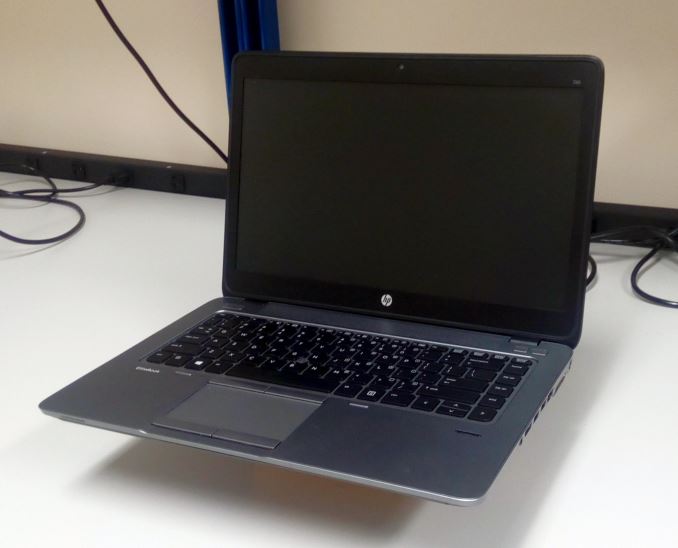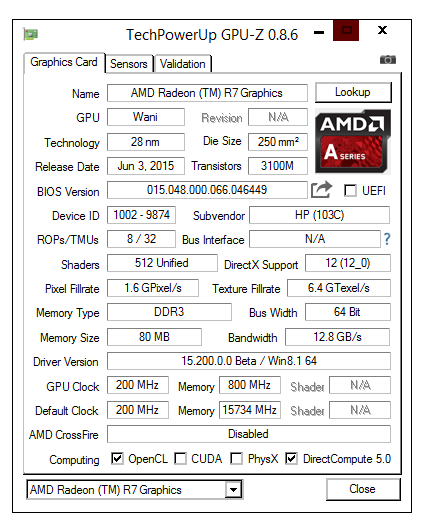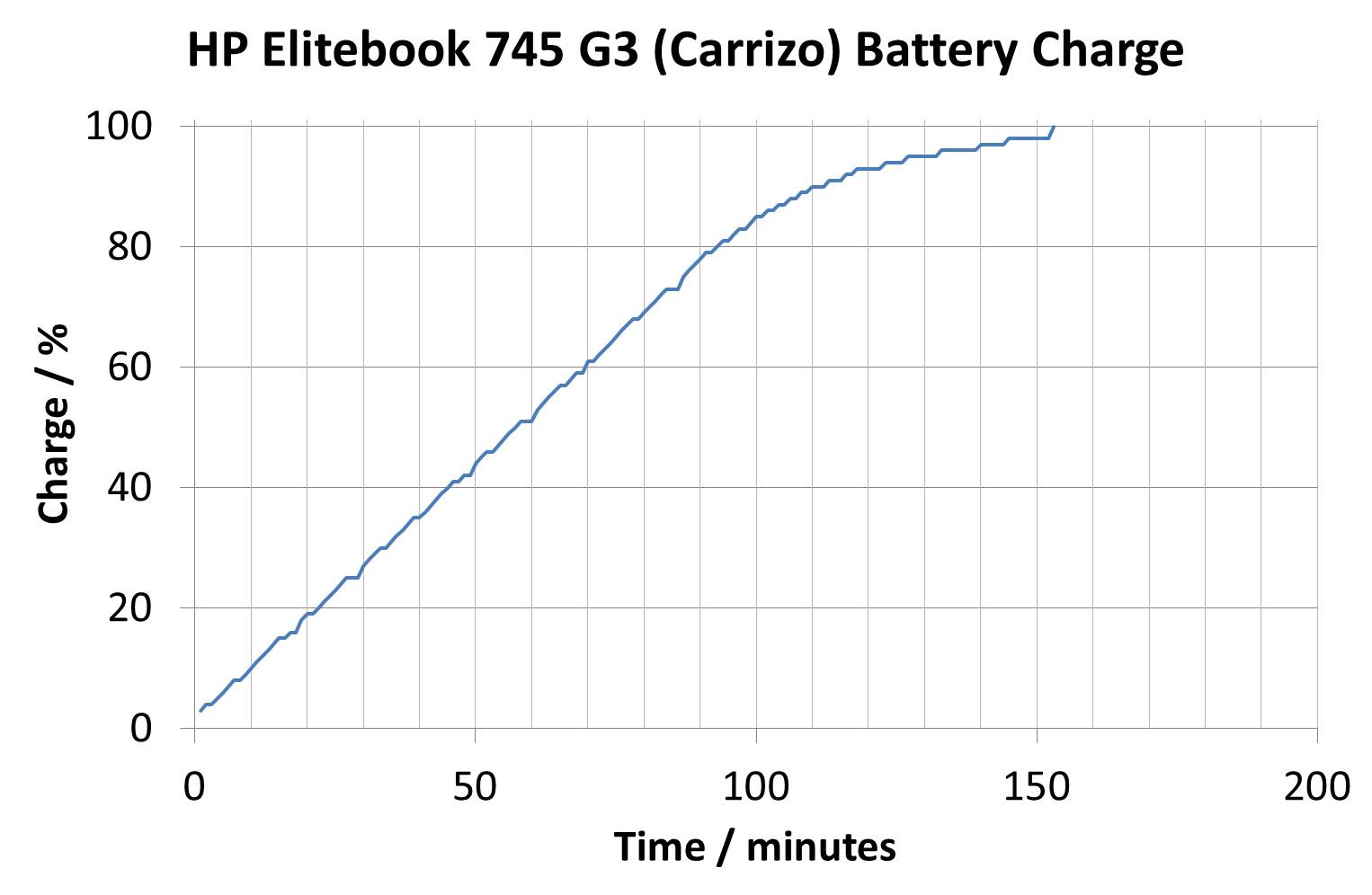Who Controls the User Experience? AMD’s Carrizo Thoroughly Tested
by Ian Cutress on February 4, 2016 8:00 AM EST#2 The HP Elitebook 745 G3 (Carrizo, PRO A12-8800B)
The Carrizo Elitebook 745 G3 looks practically identical to the Kaveri based 745 G2, so there’s no need to cover the visuals again, but the internals here cause a lot of talking points.
| HP Elitebook 745 G3 (Carrizo) Specifications | |
| Size and Resolution | 14-inch, 2560x1440 IPS |
| Processor | AMD PRO A12-8800B Dual module, 4 threads 2.1 GHz Base Frequency 3.4 GHz Turbo Frequency |
| Graphics | Integrated R7 512 Shader Cores 800 MHz maximum frequency GCN 1.2 |
| TDP | 15W |
| Memory | 4 GB in Single Channel Operation 1 x 4GB at DDR3L-1600 C11 2 SO-DIMM Slots |
| Storage | 128GB SSD |
| Battery Size | 45.76 Wh 3 cell Li-Po design, rated to 8.5 hours |
| WiFi | Broadcom Broadcom BCM943228Z 802.11ac 2x2 |
| Optical Drive | No |
| Dimensions | 13.3 x 9.3 x 0.74 in (non-touch) 13.3 x 9.3 x 0.80 in (touch) |
| Weight | 3.41 lb (non-touch) 3.76 lb (touch) |
| Webcam | 1280x720 |
| Other Features | Gigabit Ethernet 4 x USB 3.0 DisplayPort VGA Smart Card Reader |
| Operating System | Windows 8.1 |
| Website Link | link |
The G3 is almost the top premium model Carrizo you can buy, coming in at nearly $1100 if you put up the cash for the top model, which includes as much memory and storage you can fit in. For our unit, it came in at a more modest $700 ($700 for the base model, this was more $1100), which is more in-line with what price point AMD originally expected the Carrizo platform to hit. This is the first notebook with AMD’s new A12 line of processors, with this one being the PRO A12-8800B. This is a 15W part running at a base frequency of 2.1 GHz with a turbo mode up to 3.4 GHz. Any mobile APU in the A12 category has a full complement of 512 streaming processors similar to the FX mobile parts or A10 desktop parts, and the A12 runs these at 800 MHz. Unfortunately this is slightly crippled by only having the equivalent of one memory module in play, a single 4GB DDR3L-1600 module. It is dual channel capable if another is installed.
One of the big plus points with this model is the display, in comparison to the dire one on the G2, but this probably explains the majority of the cost in this 745 G3. With a 2560x1440 IPS display running a high contrast ratio (1422), it did have the best display out of what we tested for this piece. This is matched by the Wi-Fi solution, which had Broadcom’s BCM943228Z module which is an 802.11ac module in the M.2 form factor. One of the general feelings I had from the engineers here is that laptop Wi-Fi will all migrate to M.2 eventually on the understanding of better power control and form factor.
G3 Specific Testing
The 2560x1440 display varied from 0.21 nits all the way up to 297, nearly reaching the 300 mark but resulting in a 1422 contrast ratio. The white point was high, marking it up at 6657K.
While the color accuracy calibration graph looks as if the red line is the one going off on its own, it is actually the red line that is most accurate – we’re expecting a straight line through (0,0), (32,32), (64,64) and so on and while the red line is below most of these points, it isn’t as low as the green or blue.
The CPU-Z outlay shows the new FP4 socket with Carrizo over Kaveri, as well as having the full 12 compute units with those 512 SPs in tow.
On the integrated graphics side, despite the R7 graphics in there, the important element is that memory bandwidth running at 12.8 GB/s due to the single channel memory in use. We can also see the GPU clock running at 200 MHz idle, lower than the Kaveri implementation, which has power benefits.
With the 745 G3 we were able to do a run down on our light battery test, as well as run through some charge numbers.





















175 Comments
View All Comments
chris471 - Friday, February 5, 2016 - link
What do you do with all those split hares? Are they any good barbecued?("Octane splits hares between the Kaveri ...")
Ian Cutress - Friday, February 5, 2016 - link
Lightly roasted for me :) Edited, thanks!maglito - Friday, February 5, 2016 - link
Were you able to test 18Gbps HDMI? The ability to drive an external display with 2160p 4:2:2 @ 60Hz? I guess the lack of a 10bit accelerated video decoder almost makes the point moot for future 2160p content though....Otherwise, fantastic article!
MonkeyPaw - Friday, February 5, 2016 - link
Last time I shopped for a laptop (which was recently), I was considering an A10-based HP with a 1080p screen. The problem I saw was in reviews the battery life was really poor. It looked like HP put a small battery in it, making the thing only worthy as a DTR. I ended up going with a Lenovo with an i3. I guess part of the problem is that there are so many variants of laptops that finding a review of a specific model is impossible, and all you have to go on are things like Amazon or Best Buy ussr reviews, which can be extremely painful to read.Lolimaster - Friday, February 5, 2016 - link
HP sometimes release near "nice" AMD laptops but always cripples it with laughable battery capacities, same models intel inside dont get the nerfs.euskalzabe - Friday, February 5, 2016 - link
That was a wonderful article that I thoroughly enjoyed reading to start my Friday. Long story short, you perfectly define my laptop buying rationale with "SSD, dual channel memory, 8 hours+ light battery, under 2kg, Full HD IPS panel".That's why I bought an i5 UX305. I wanted an AMD machine because I plain like the company and would like them to succeed to bring more competition to Intel, but I found NOTHING even close to the specs you mentioned. The UX305 fit the description perfectly and cost me $750. It was an immediate purchase for me. If AMD managed the OEM relationship to create such a machine, it would be an insta-buy for me. Also, Zenbooks with Zen APUs oculd be a great marketing strategy :)
Shadowmaster625 - Friday, February 5, 2016 - link
AMD is a company that shoots itself in the foot at every opportunity. I am truly perplexed. Their cat cores shouldnt even exist. But not only do those crippled parts exist, they crippled their premium parts by combining the two platforms! WHY? How could they not see that every notebook would be single channel? They wasted the entirety of their ATI purchase, as you can see with the Rocket League results vs Intel. This is a disgrace.AMD needs to realize that it IS AMD who controls the User experience. Look at the Mackbook Air. Look at the Surface Pro. Look at the Playstation 4 and Xbox One. All of these platforms have a set minimum level of performance. Sure they might be more expensive than a $300 atom clunker, but at least the user will not throw the thing out the window after pulling their hair out.
AMD needs to put a floor under their products. 4 cores. 8GB of unified HBM. 512 cores GPU. This is the SoC that they need. Sure they can fuse off a core or whatever to harvest bad dies, but this is the minimum die they should be making. Ideally within 2 years they will move to a 4 core, 16GB HBM, and they will replace one stack of HBM with 128GB of HBF. They need to control the memory bandwidth of their SoC. Take away the ability of the OEMs to cripple performance. Use HBF to take away the ability for OEMs to cripple storage performance also. Do this, and every AMD system will be fast. And it will get design wins.
t.s - Friday, February 5, 2016 - link
If you read the article: AMD not crippled their premium parts. It was OEM. If only OEM create mobos that have dual channel mems.xthetenth - Friday, February 5, 2016 - link
OEMs shaving pennies is as universal a phenomenon as gravity, and designs should be made as such.t.s - Thursday, February 11, 2016 - link
hence the title, "who controls user experience" :)